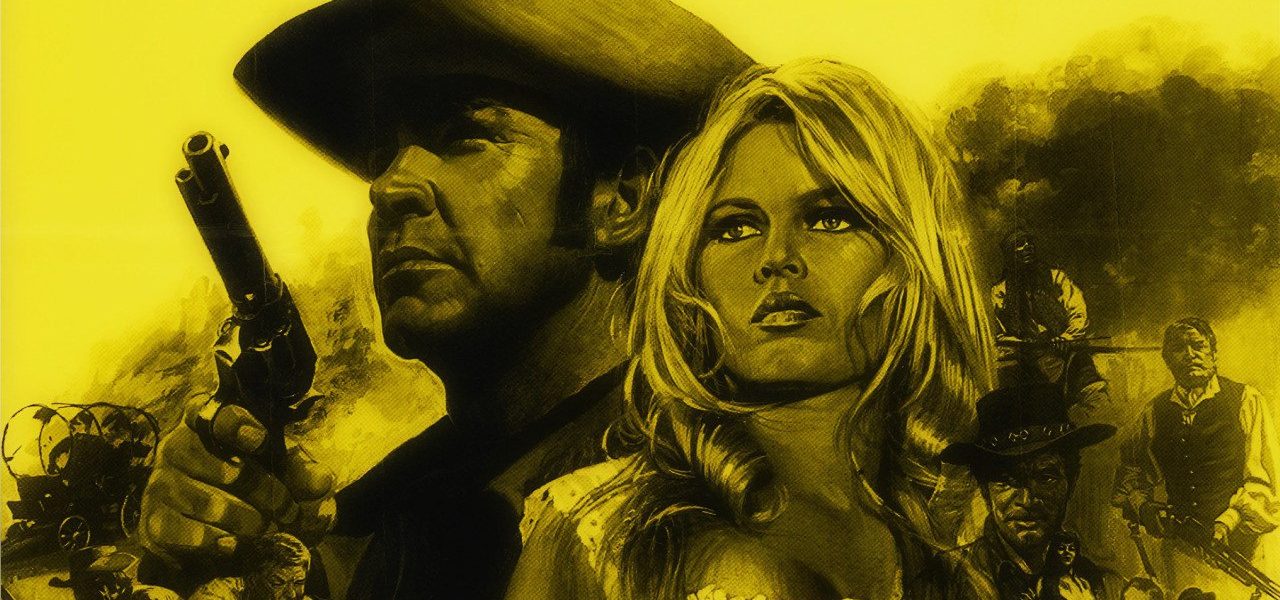Connery and Bardot Battle to Survive in L’Amour Adaptation
DIRECTED BY EDWARD DMYTRYK/1968
STREET DATE: JULY 11, 2017/KINO LORBER STUDIO CLASSICS
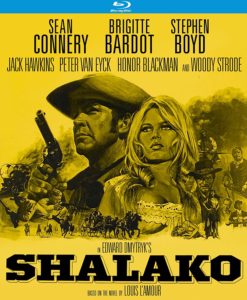 A middle-of-the-road survival Western, 1968’s Shalako is elevated by the novel nature of its cast.
A middle-of-the-road survival Western, 1968’s Shalako is elevated by the novel nature of its cast.
Sean Connery plays the title character, a lone trapper on the desolate New Mexico landscape. (Actually Almería, Spain). At this point a superstar trying to shake free of the 007 role that got him to that point, Connery is reasonably commanding in the lead. His knowing rogue with a heart of gold is a West-weary version of the type of alienated loner James Stewart would play for director Anthony Mann in the 1950s, and “the Man with No Name” whom Clint Eastwood would embody for Sergio Leone in the earlier years of the 1960s. He may not bring anything fresh to the archetype he’s embodying, but he sells it without strain.
Brigitte Bardot is “the girl” in the movie, a fair and French Lady shooter of the globe-traveling upper crust. This being one of her later screen roles before giving up acting forever, one wonders what drew the international superstar to this supporting role out in the middle of nowhere. One also wonders if her forsaking her film career to devote the rest of her life to animal rights came about because of this movie. In it, her character blasts a cornered mountain lion for sport; later, Indians murder three German shepherds (Not for real! This isn’t a foreign film.); numerous horses are put through the wringer, and finally, Connery bashes the living daylights out of a rattlesnake, seemingly only because no one knew how else to end that particular scene. In any case, Bardot is as charming and alluring as ever, with a good hint of the inner drama that she so famously displayed in Godard’s Contempt.
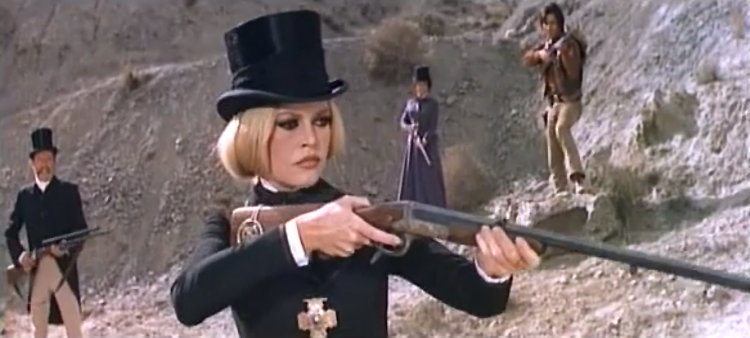
Bardot at the beginning of SHALAKO.
Stephen Boyd and Jack Hawkins, co-stars of 1959’s Ben-Hur and two other films, reunite here. Boyd plays his lean, grizzled opportunist character with glassy-eyed aplomb; Hawkins is his put-upon nemesis. These two, in their respective wearing and tearing, most certainly flesh out the tactile reality so essential to this film’s success and appeal.
Another notable reunion, if only in the credits list, are Connery and Goldfinger‘s Pussy Galore herself, Honor Blackman. Although the two share no real moments together in Shalako, it could be well argued that her character is the true female lead in the story. Unlike Bardot’s character, for whom it’s all downhill following her bagging of the mountain lion in the early minutes of the movie, Blackman gets to do some things throughout.
When it comes to sex symbols on horses and firing guns, it’s got the goods. This was certainly the primary selling point in 1968. But considerably more so than that, it’s the awkward collision of Western genre sensibilities past and future that give Shalako its most resonant qualities.
Though veteran director Dmytryk can in no way be accused of phoning this one in, there is something glaringly unremarkable about this later-career effort. Being that the prolonged climax of the film has our protagonists attempting to escape a major Apache ambush by scaling the sharp side of a tall mountain pass, only to find themselves in a showdown anyway, Shalako is not lacking for physical daring. Despite its more obvious attempts at exploiting American cinema’s emerged permissiveness of increased violence (some blood, particularly as Shalako simply stands by and lets a man die brutally) and sex (Bardot has a topless rinse by a river, her breasts covered all the while) it’s that the film nonetheless is invariably rooted in a lingering 1950’s Hollywood Western sensibility – and not in a nostalgic way.
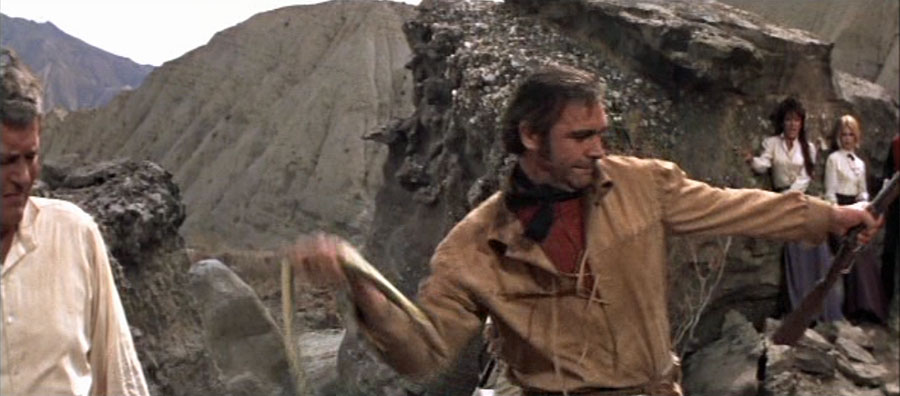
Snake killer Shalako.
Case in point, Shalako opens with an earnest theme song that sings the storyline… three times. The blustery song loops multiple times over the opening titles before the movie proper gets going. Then, as though to compensate, it’s the mountain lion scene, edited Bonnie & Clyde style. The sudden shift in filmmaking sensibility only underscores the odd tension of Shalako. It’s Louis L’Amour material embodied by James Bond in a leather trader’s outfit. On one hand, it’s a rightly passable Western about a rogue putting aside his wandering ways to aid a group in a situation of life and death. But on the other hand, one can feel the specter of The Wild Bunch, which was still one year away, just itching to break out.
That said, Dmytryk acquits himself quite well, plowing the narrative forward, keeping boredom at bay. The depiction of the Apaches is stuck in the cultural mud, complete with African-American actor Woody Strode playing the main native antagonist. So, not exactly the progressive agenda one might expect from a member of the witch hunted “Hollywood Ten”, but then again, Dmytryk served his prison sentence a long time ago at this point in his life. One would understand why, after not only nearly losing his career, but also losing his freedom, he might’ve been inclined to “play it safe”, and do the central job of making the hero Shalako look cool.
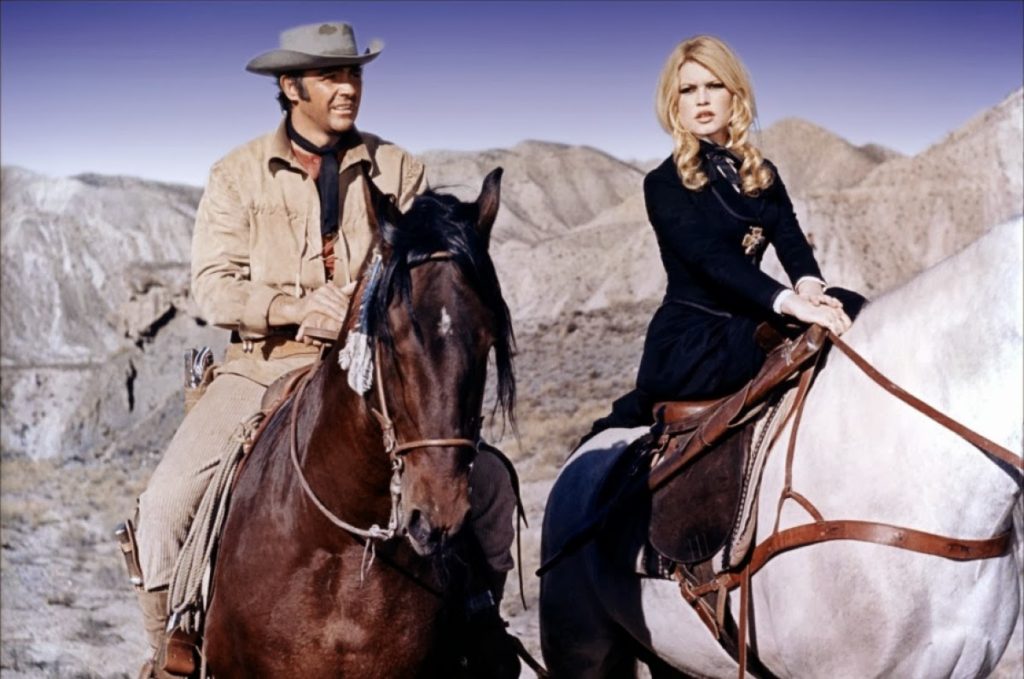
Filmmaker and film history expert Alex Cox (Repo Man) tells us as much in the early moments of his very knowledgeable commentary track, detailing Dmytryk as a competent “set of hands” whom major studios felt trusting of. Such a career may not have yielded many if any masterpieces, but Dmytryk kept busy for most of it even with the prison stint.
The new Blu-Ray edition of Shalako looks and sounds nice, even as it shows its age in some respects. Having never experienced the film prior, it’s hard to truly know whether the generally murky look is intentional or the result of the print fading. No shortage of film grain, that’s for sure – which is a positive, in terms of authentic presentation. Colors appear accurate even as the clay colored desert landscape dominates the palate.
According to Cox, Shalako was a bit of a big deal upon its release. Looking at it now, it’s an entirely passable, if sometimes problematic cinema curio. When it comes to sex symbols on horses and firing guns, it’s got the goods. This was certainly the primary selling point in 1968. But considerably more so than that, it’s the awkward collision of Western genre sensibilities past and future that give Shalako its most resonant qualities.


